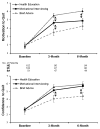A Randomized Trial of Motivational Interviewing: Cessation Induction Among Smokers With Low Desire to Quit
- PMID: 26711164
- PMCID: PMC4841713
- DOI: 10.1016/j.amepre.2015.10.013
A Randomized Trial of Motivational Interviewing: Cessation Induction Among Smokers With Low Desire to Quit
Abstract
Introduction: Despite limitations in evidence, the current Clinical Practice Guideline advocates Motivational Interviewing for smokers not ready to quit. This study evaluated the efficacy of Motivational Interviewing for inducing cessation-related behaviors among smokers with low motivation to quit.
Design: Randomized clinical trial.
Setting/participants: Two-hundred fifty-five daily smokers reporting low desire to quit smoking were recruited from an urban community during 2010-2011 and randomly assigned to Motivational Interviewing, health education, or brief advice using a 2:2:1 allocation. Data were analyzed from 2012 to 2014.
Intervention: Four sessions of Motivational Interviewing utilized a patient-centered communication style that explored patients' own reasons for change. Four sessions of health education provided education related to smoking cessation while excluding elements characteristic of Motivational Interviewing. A single session of brief advice consisted of brief, personalized advice to quit.
Main outcomes measures: Self-reported quit attempts; smoking abstinence (biochemically verified); use of cessation pharmacotherapies; motivation; and confidence to quit were assessed at baseline and 3- and 6-month follow-ups.
Results: Unexpectedly, no significant differences emerged between groups in the proportion who made a quit attempt by 6-month follow-up (Motivational Interviewing, 52.0%; health education, 60.8%; brief advice, 45.1%; p=0.157). Health education had significantly higher biochemically verified abstinence rates at 6 months (7.8%) than brief advice (0.0%) (8% risk difference, 95% CI=3%, 13%, p=0.003), with the Motivational Interviewing group falling in between (2.9% abstinent, 3% risk difference, 95% CI=0%, 6%, p=0.079). Both Motivational Interviewing and health education groups showed greater increases in cessation medication use, motivation, and confidence to quit relative to brief advice (all p<0.05), and health education showed greater increases in motivation relative to Motivational Interviewing (Cohen's d=0.36, 95% CI=0.12, 0.60).
Conclusions: Although Motivational Interviewing was generally more efficacious than brief advice in inducing cessation behaviors, health education appeared the most efficacious. These results highlight the need to identify the contexts in which Motivational Interviewing may be most efficacious and question recommendations to use Motivational Interviewing rather than other less complex cessation induction interventions.
Trial registration: This study is registered at www.clinicaltrials.gov NCT01188018.
Copyright © 2016 American Journal of Preventive Medicine. Published by Elsevier Inc. All rights reserved.
Figures


References
-
- Velicer WF, Fava JL, Prochaska JO, Abrams DB, Emmons KM, Pierce JP. Distribution of smokers by stage in three representative samples. Prev Med. 1995;24(4):401–411. http://dx.doi.org/10.1006/pmed.1995.1065. - DOI - PubMed
-
- Herzog TA, Blagg CO. Are most precontemplators contemplating smoking cessation? Assessing the validity of the stages of change. Health Psychol. 2007;26(2):222–231. http://dx.doi.org/10.1037/0278-6133.26.2.222. - DOI - PubMed
-
- Fiore MC, Jaen CR, Baker TB, et al. Treating Tobacco Use and Dependence: 2008 Update. Clinical Practice Guideline. Rockville, MD: DHHS. Public Health Service; 2008.
-
- Miller W, Rollnick S. Motivational Interviewing: Helping People Change. 3. New York: Guilford Press; 2013.
Publication types
MeSH terms
Associated data
Grants and funding
LinkOut - more resources
Full Text Sources
Other Literature Sources
Medical

